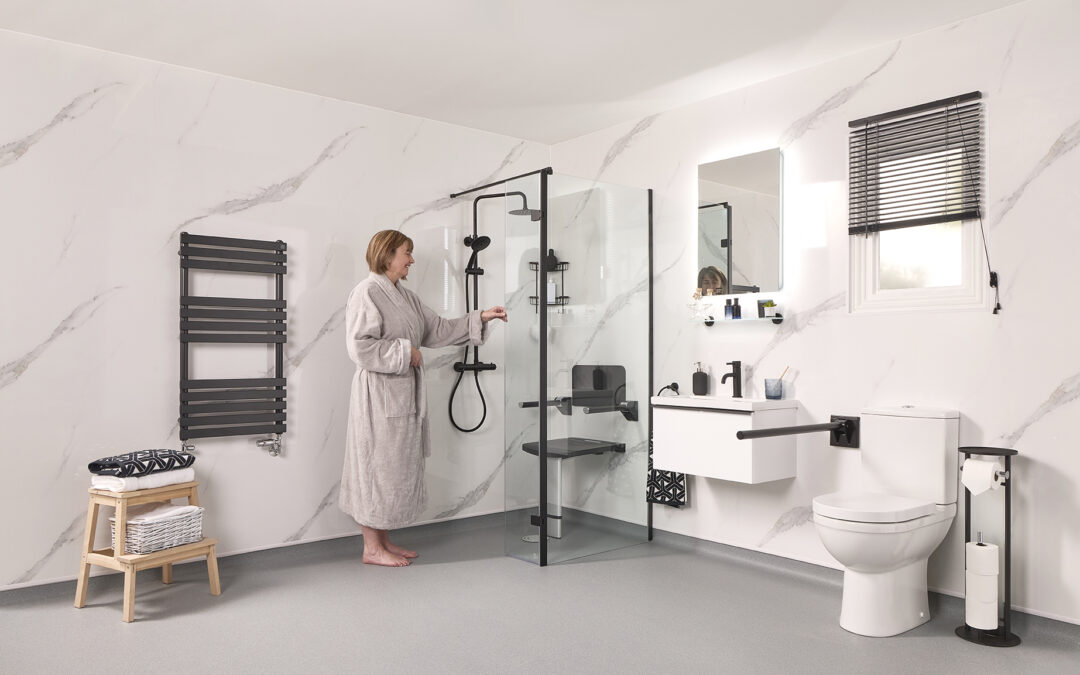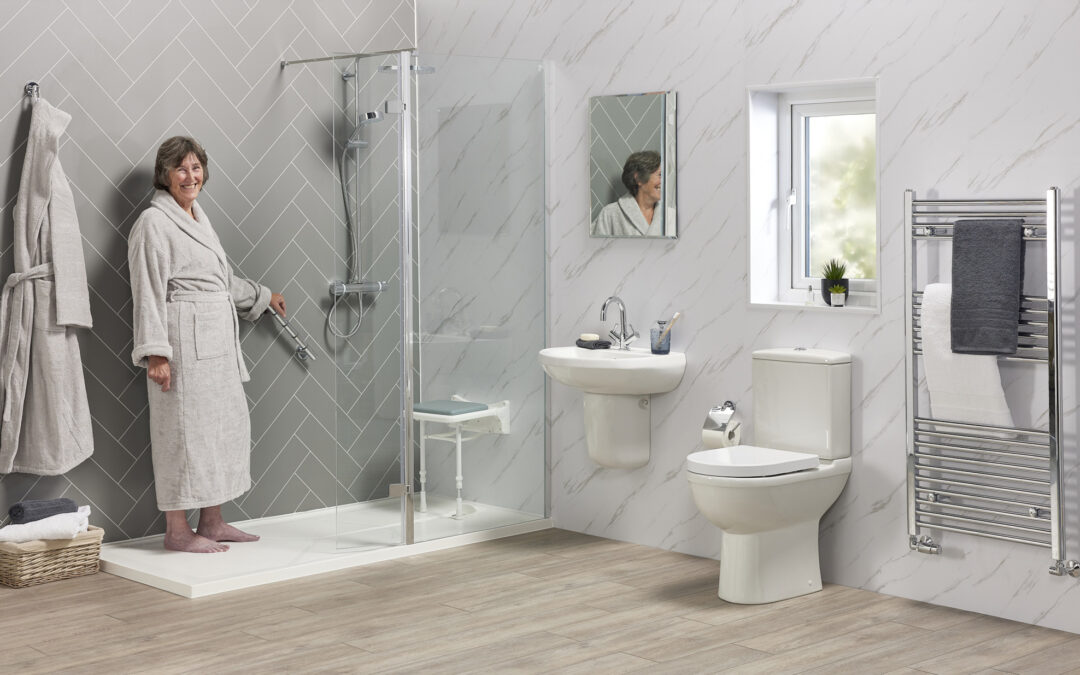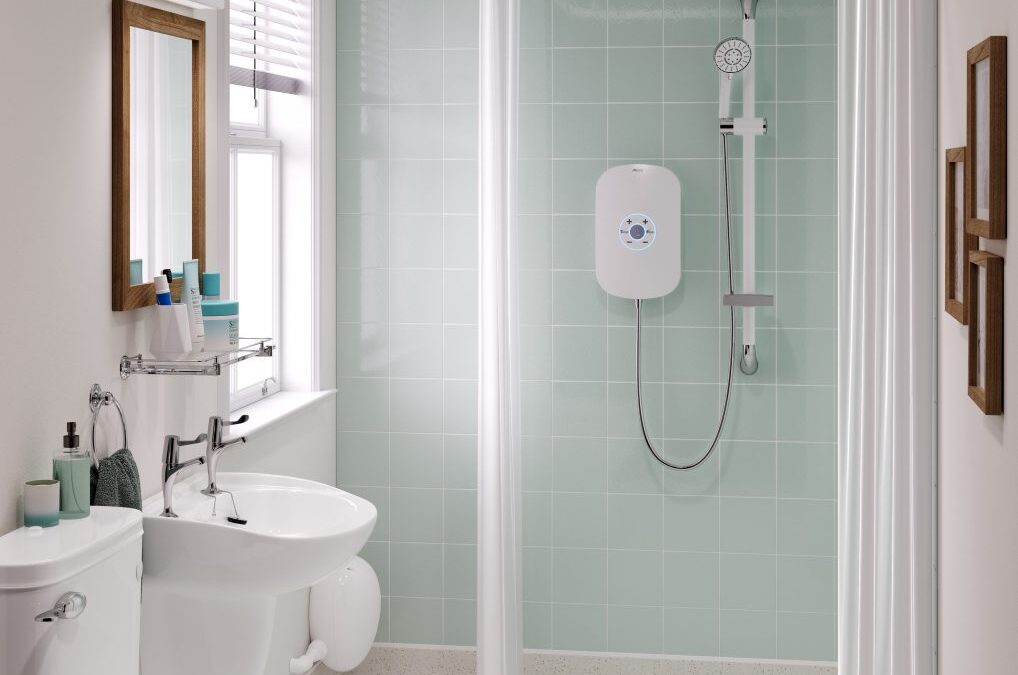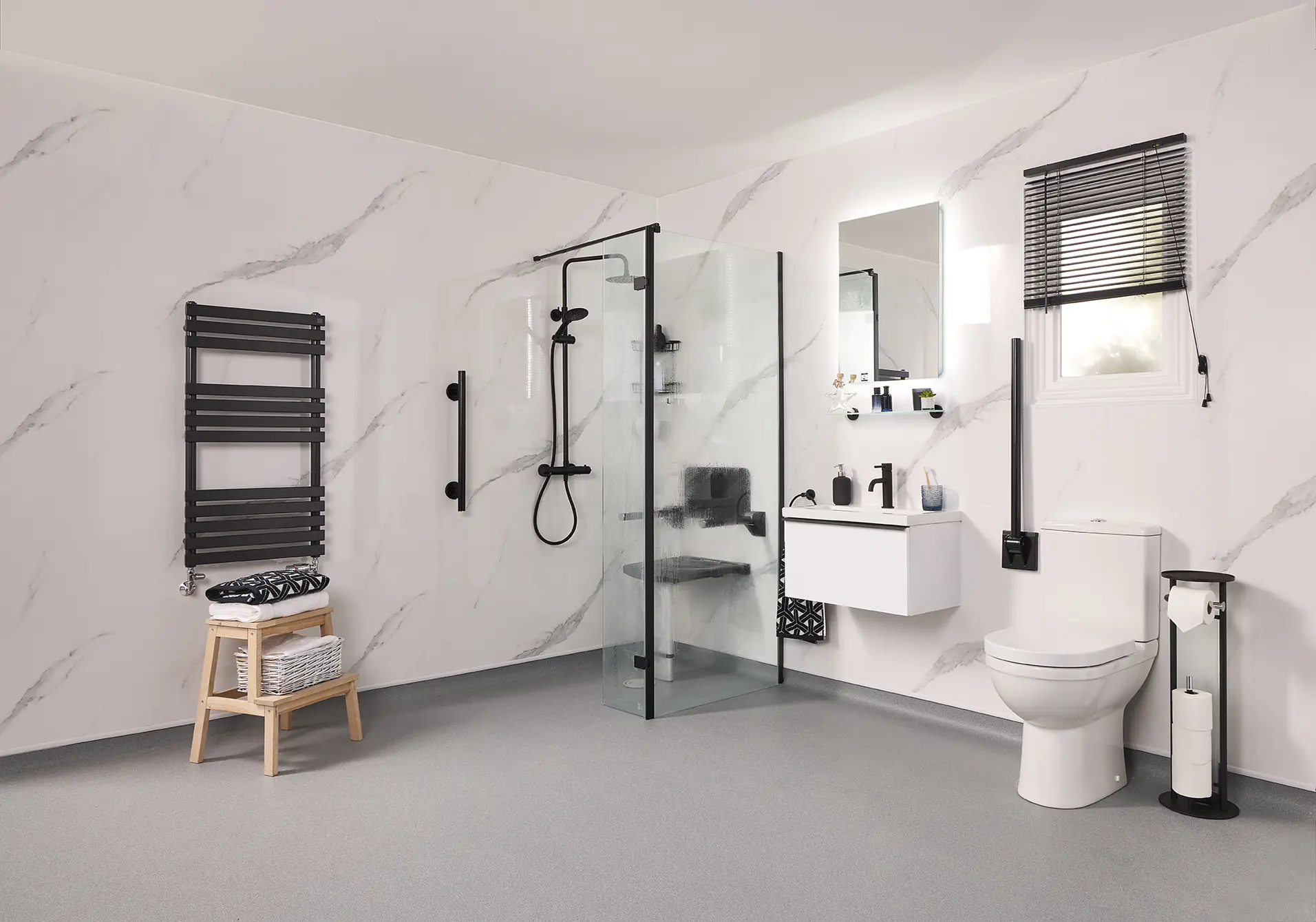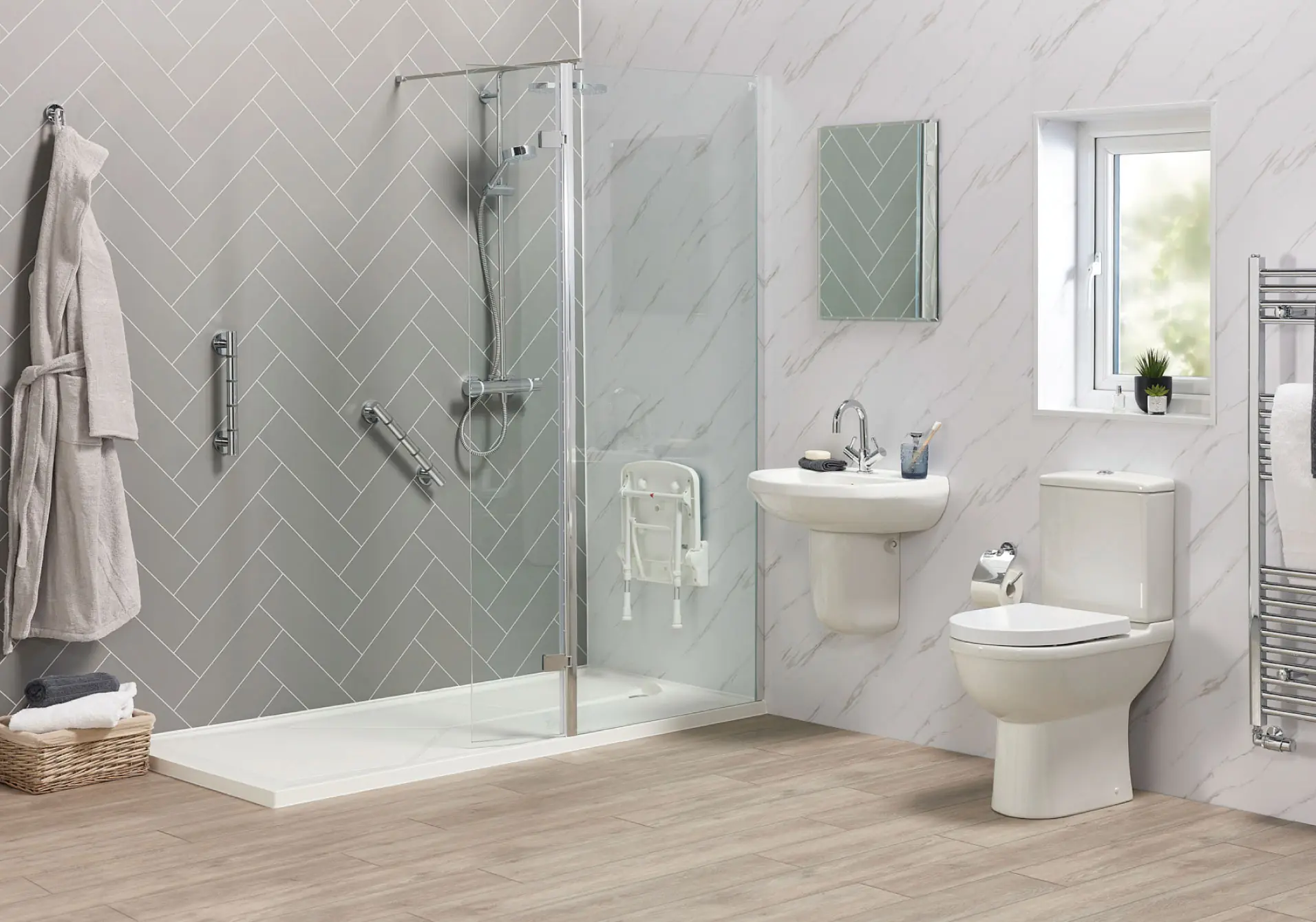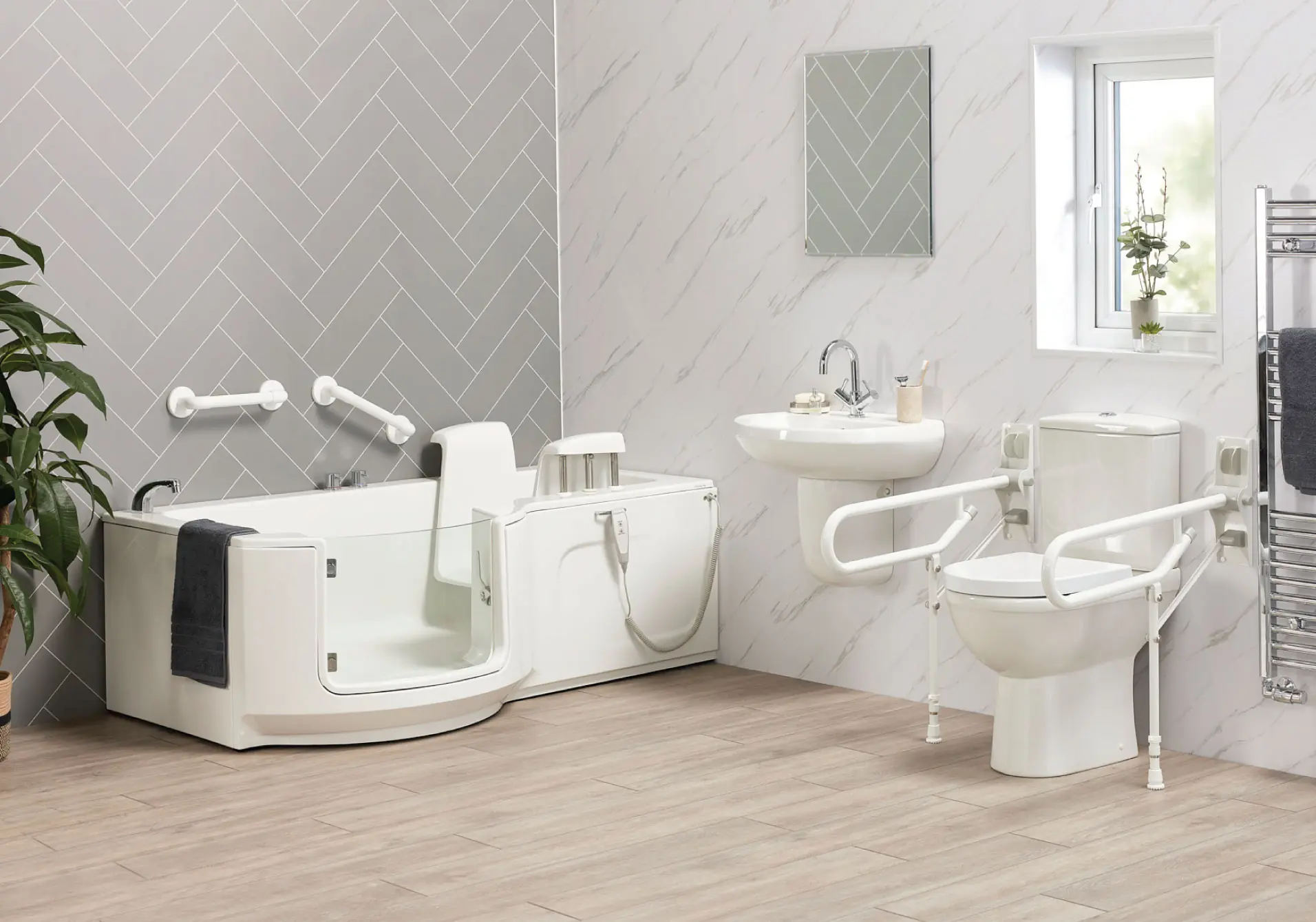Table of Contents
With our population ageing and better outcomes for people with life-changing injuries and illnesses, we are seeing a steady upward trend in the number of people coping with some form of disability or limitation. For these people, the bathroom can present challenges every day that carry the risk of harm.
But there are ways in which the bathroom can be made disability-safe and some of these are both inexpensive and easy adaptations to an existing bathroom.
Here are our top ten suggestions for how you can use mobility aids to make your bathroom safer, particularly for anyone with limitations.
1. Prevent slips
With falls in UK bathrooms (and many falls start with slipping) annually accounting for 54,000 visits to A&E and 80 deaths, preventing slips is the single most important change you can make to improve bathroom safety, particularly as the elderly and mobility-impaired are the most vulnerable.
Wet bathroom floor tiles and shower trays can be extremely slippery, especially if the water still contains residues of soap or shampoo. Although non-slip bath mats may be a temporary solution these can also be a trip hazard, so anti-slip shower trays and floor coverings are the only completely safe options.
Companies specialising in adapted bathrooms are the best source of information on these products, as they will be able to supply and fit products that are especially suited to elderly, infirm and disabled users.
2. Install a level-access shower
Trips also account for many bathroom falls and for anyone who finds it hard to raise their feet, a shower threshold can be a major obstacle.
Swapping your old shower tray for a level access shower will virtually eradicate this risk. The shower tray is set flush with the bathroom floor and has a shallow lip of 10mm or less.
3. Convert to a wet room
Now widely installed in luxury homes and hotels for their sleek, minimalist styling, wet rooms are also an affordable and very practical option for mobility-enabled bathrooms.
To create a wet room, the entire floor is waterproofed and contoured to direct all water to an integral drain outlet. Anti-slip flooring material is then laid across the entire floor to complete the fully sealed finish. This eliminates the need for a threshold or lip between the shower and the rest of the room.
Another benefit of a wet room is that because the shower area doesn’t need to be totally enclosed or require a door, access is much improved, particularly for wheelchair users.


If you are considering installing a wet room, this is definitely something you should discuss with a bathroom adaptation specialist as they have the experience and skills needed to design and install a wet room that fully meets your needs.
4. Improve the lighting
With advancing age and some illnesses, some people find it harder to distinguish the outlines of familiar objects. Upgrading bathroom lighting can make this easier for them so they can more accurately judge distances and avoid collisions, trips and falls.
You might also want to consider installing motion sensor-activated lights or automatic night lighting in the bathroom for those necessary nocturnal visits.
A professional bathroom adaptations company will be able to advise you on the most suitable lighting for your bathroom based on physical and visual limitations.
5. Add grab rails
A securely fixed grab rail in a shower or next to a toilet or bath can offer both support and assurance to anyone who needs assistance with sitting down, standing up or staying in a standing position for any length of time. If space is limited, a drop-down rail will provide full support and then fold up out of the way when not required.
Grab rails are made in a wide range of shapes, styles and finishes for different functions and positions. We would always recommend using a bathroom adaptations company as they will be able to advise on, supply and correctly install the most appropriate rails for your needs.
6. Raise the toilet
Using a standard height toilet can be difficult for people with mobility issues, as they create an uncomfortable sitting position that puts unnecessary pressure on knees and joints.
A raised, comfort-height toilet reduces this pressure and is also easier for users to sit down and raise themselves from the seat.
7. Put a seat in the shower
Showering is a quick and easy way to maintain daily personal hygiene, and for anyone unable to stand for long or at all, a shower seat may be needed.
Several styles of shower seats are available including freestanding, fixed and foldable. While these may be available from mail order catalogues and other non-specialist suppliers, we would recommend seeking the advice of a specialist mobility aids or bathroom adaptations provider to ensure you have the best type of chair for your needs and shower area.
8. Install a bath lift
Soaking in a bath is still the way that many people prefer to bathe, and it certainly has health and well-being benefits. If getting in and out of the bath is too much of a challenge, a bath lift can be easily installed over an existing bath.
Despite the amazing benefits this brings, it can be surprisingly easy to install without making other changes to the bathroom. Take the Hydrolift from EA Mobility as one example.
For a start, it is battery-operated so needs no electrical work during installation. It also fits above the bath and retracts unobtrusively so that the bath can also be used conventionally.
How to use a bath lift?
To use bath lift, like the Hydrolift, you simply position yourself on the non-slip safety seat that straddles the side of the bath, then swing your legs over the side, slide onto the anti-slip belt and use a button on the lift unit or a handheld control to lower yourself into the water.
When your bath is over, simply use the lift to raise you from the water until you are level with the seat, and exit the bath.
While a bath lift may not need the services of a qualified electrician, we would recommend that a professional bathroom adaptations company is used for the installation as they will fit it correctly and securely and ensure you are familiar with its safe operation.
9. Change your taps
For disabilities such as arthritis that limit hand strength and movement, conventional bath and basin taps can be very difficult to use. Changing these to easy lever-style fittings can make running a bath and washing hands much safer as they can be quickly turned off to prevent overflowing or scalding.
Changing the taps is a simple task for a qualified plumber. If you are considering wider changes to your bathroom to make it disability- or elderly-safe, this is one feature you should definitely consider.
10. Fit an anti-scald shower valve
With many conventional shower valves, a drop in cold water pressure when the system is used elsewhere in the house can cause sudden surges in the water temperature. With 60-65C being the recommended thermostatic setting for a domestic water heater, water at that temperature can cause third-degree burns in only five seconds.
An anti-scald shower valve constantly monitors the temperature of the water passing through and will prevent this from exceeding safe limits, even during drops in mains water pressure.
This is one feature that a professional bathroom adaptations advisor will consider when designing a bathroom for an elderly or disabled client.
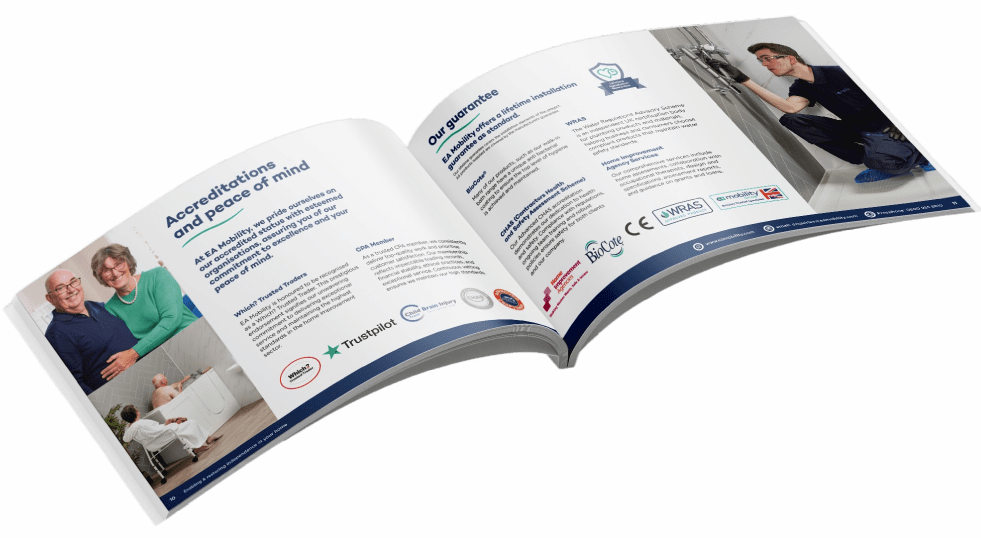

Request a Brochure
Receive a FREE copy of our latest full-colour brochure and browse our range of assisted and independent bathing products from the comfort of your own home.
How EA Mobility can help
As a specialist bathroom adaptation provider, we have many years of experience and a wide range of solutions that can be tailored to your individual needs.
We also strive to create pleasant bathroom environments where you can begin and end each day in comfort, using products that are stylish as well as functional.
Every client’s needs are different, which is why we like to start with a visit from one of our home assessors. This is completely free and without any obligation to use EA Mobility for your bathroom adaptation.
It’s also an opportunity for us to get to know you personally and to assess your needs while giving you professional, unbiased and personal advice on how your bathroom can be adapted.
If you choose to use EA Mobility for your bathroom adaptation our designers, fitters, electricians, plumbers and decorators will manage the entire project from concept to completion, working to the highest standards and with minimal disruption to your home and life.
If you would like to book a visit from one of our home assessors, please call us on 0800 468 1023 or fill out our online contact form and we will respond promptly.




